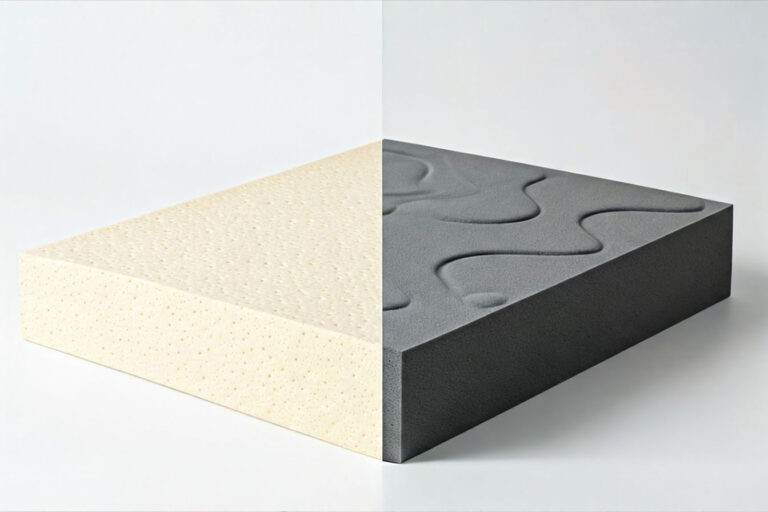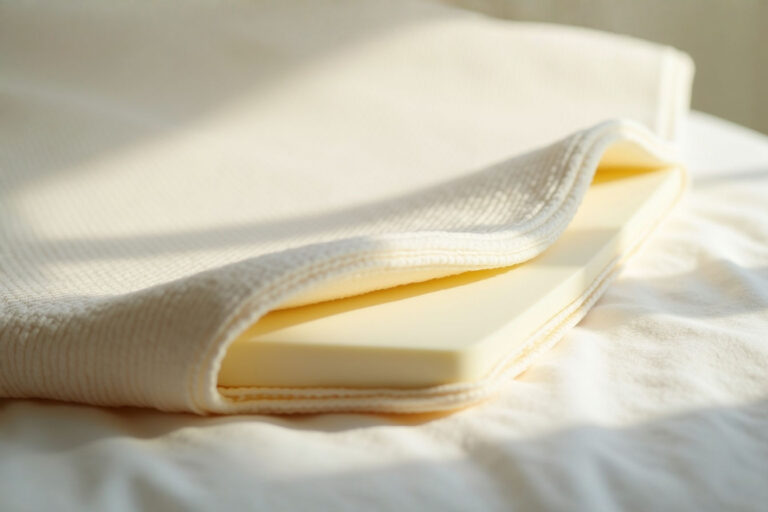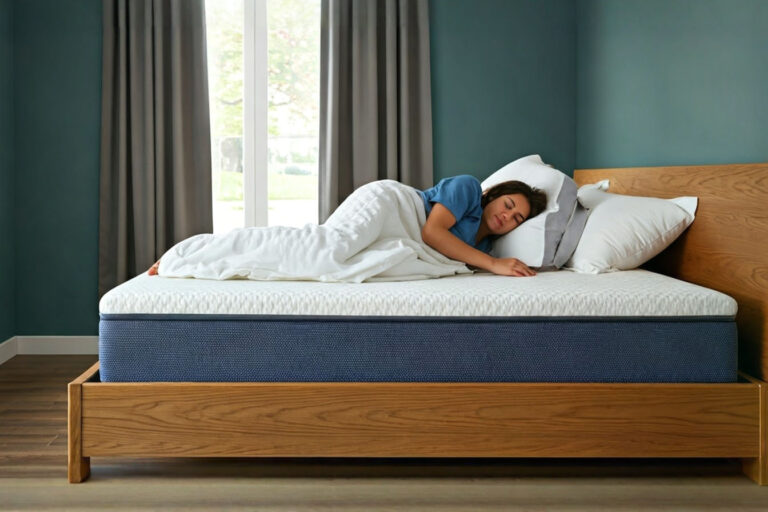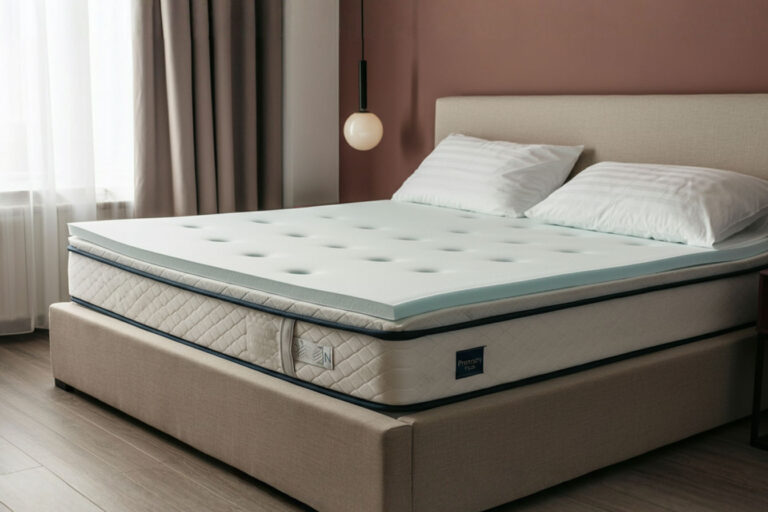King Size Topper Mattress: Custom Zones That Support Both Partners’ Sleep Positions
Can couples with different sleep preferences find comfort in the same bed? Custom zoned king toppers offer personalized support for each partner without compromise. Find your solution.

Sharing a bed should be an intimate experience that strengthens your relationship, not a nightly battle for comfort that leaves one or both partners exhausted. Yet many couples face this exact dilemma when their sleep preferences differ. She might be a side sleeper who prefers a plush surface, while he needs firm support for his back. The conventional solution of “meet in the middle” often results in neither person sleeping optimally.
Enter the revolutionary world of custom zoned king size mattress toppers. These innovative sleep solutions offer personalized comfort for both partners, allowing each person to enjoy their preferred firmness level and support exactly where they need it most. Unlike traditional mattress toppers that offer a uniform feel across the entire surface, zoned toppers feature distinct sections engineered to support different sleep positions and body types simultaneously.
This comprehensive guide explores how these specialized toppers work, the science behind their effectiveness, and how they can transform sleep quality for couples with divergent comfort needs—all without the expense of replacing your entire mattress.
Understanding Sleep Position Requirements
Before diving into the specific benefits of zoned toppers, it’s essential to understand why different sleep positions demand different types of support. Your preferred sleeping position significantly impacts which parts of your body experience pressure and how your spine aligns during those crucial hours of rest.
Side Sleeper Needs
Side sleeping ranks as the most common position among adults, particularly favored by women. This position creates concentrated pressure points at the shoulders and hips, where body weight focuses on relatively small contact areas.
Side sleepers typically benefit from softer, more yielding surfaces that allow these pressure points to sink in slightly while still supporting the waist to maintain proper spinal alignment. Without adequate pressure relief, side sleepers often experience shoulder pain, hip discomfort, and even numbness in arms due to compressed nerves.
The ideal support for a side sleeper provides a cradling effect for shoulders and hips while filling the gap at the waist, creating a straight spine from neck to tailbone. Memory foam with targeted softness zones often addresses these needs effectively.
Back Sleeper Needs
Back sleeping represents the healthiest position for spinal alignment when properly supported. This position distributes weight more evenly than side sleeping but creates specific pressure points at the shoulders, lower back, and heels.
Back sleepers generally require medium-firm support that prevents the hips from sinking too deeply while cradling the natural curve of the lower back. The right balance keeps the spine in its natural “S” curve, reducing strain on the lower back muscles that often leads to morning stiffness and discomfort.
Ideal support for back sleepers involves a slightly firmer surface overall with strategic cushioning in the lumbar region. Materials that respond to weight and temperature, like certain foams and latex, can provide this balanced support effectively.
Stomach Sleeper Needs
Though stomach sleeping ranks as the least common position and receives caution from many sleep experts due to potential neck strain, those who prefer it have very specific support requirements.
Stomach sleepers need firmer, flatter surfaces to prevent excessive sinking of the midsection, which can hyperextend the lower back and create painful pressure. The minimal cushioning helps maintain a more neutral spine position while still providing comfort.
The ideal support for stomach sleepers offers consistent firmness with just enough softness to cushion the ribcage and hip bones. Very responsive materials like latex often work well for these sleepers, as they prevent the feeling of “sinking in” that can be claustrophobic in this face-down position.
Combination Sleeper Considerations
Many people don’t remain in one position throughout the night. These combination sleepers shift between two or more positions and need surfaces that accommodate this movement while providing appropriate support for each position.
Combination sleepers benefit from responsive materials that adapt quickly as they change positions. Too much contouring can create “valleys” that make movement difficult, while too little cushioning fails to relieve pressure in side-sleeping positions.
The ideal support for combination sleepers balances pressure relief with ease of movement, often achieved through materials like latex or responsive foam blends that recover quickly when weight shifts.
The Science Behind Zoned Support
The technology behind zoned mattress toppers isn’t merely marketing hype—it’s grounded in sleep science and ergonomics. Understanding how these systems work helps explain their effectiveness for couples with different needs.
Pressure Point Mapping
Modern mattress design often begins with pressure mapping—a scientific process that uses sensors to measure exactly how much pressure builds at different points when a person lies on a surface. These detailed maps reveal where customized support might benefit different body types and sleep positions.
Pressure mapping studies consistently show that different body parts need different levels of support. For instance, shoulders and hips benefit from softer surfaces that allow them to sink slightly, while the lower back needs firmer support to maintain proper alignment.
This research directly influences the design of zoned toppers, determining where firmer and softer sections should be placed for optimal pressure distribution. The most advanced designs incorporate multiple zones that correspond precisely to these pressure map findings.
Spinal Alignment Principles
The fundamental goal of any quality sleep surface centers on maintaining proper spinal alignment—keeping your spine in the same natural position it would have when standing with good posture.
Zoned support systems work by providing variable resistance based on where your body applies pressure. Heavier areas like the hips receive firmer support to prevent excessive sinking, while lighter areas receive appropriately softer support.
This tailored approach helps maintain the natural curve of the spine regardless of sleep position. For side sleepers, this means keeping the spine horizontal from shoulder to hip. For back sleepers, it preserves the natural S-curve. The result is fewer pressure points, reduced tossing and turning, and decreased likelihood of waking with pain or stiffness.
Weight Distribution Factors
Body weight and its distribution play crucial roles in determining optimal mattress support. Heavier individuals typically need firmer surfaces to prevent excessive sinking, while lighter individuals may find the same surfaces uncomfortably rigid.
Custom zoned toppers account for weight differences between partners by allowing each side of the bed to provide appropriate support for that person’s weight and build. This personalization becomes particularly important when partners have significant weight disparities.
The best systems accommodate not just different weights but different weight distributions. For instance, someone who carries more weight in their midsection needs different support patterns than someone with broader shoulders relative to their hips.
Sleep Ergonomics
Sleep ergonomics—the science of designing sleep environments that work with your body’s natural mechanics—informs the development of zoned support systems. This discipline examines how different body positions affect muscle tension, joint alignment, and circulation during sleep.
Ergonomic research demonstrates that appropriate support reduces muscle activity during sleep. When your mattress properly supports your body’s curves, your muscles can truly relax rather than working to maintain alignment. This deeper relaxation contributes to more restful, restorative sleep.
Zoned toppers apply these ergonomic principles by strategically varying support to work with, rather than against, your body’s natural structure. The result is not just comfort but genuinely improved sleep quality verified through sleep lab research.
Types of Customizable King Size Toppers
The market offers several distinct approaches to creating customized sleep zones for couples. Each technology has unique advantages worth considering when selecting the right solution for your needs.
Memory Foam Zoned Toppers
Memory foam toppers with built-in zones use variations in foam density, cut patterns, or layered designs to create different support regions. These toppers respond to body heat and weight, gradually contouring to your shape.
The adaptive nature of memory foam works particularly well for couples with moderate differences in their support preferences. The material’s ability to isolate motion also means one partner’s movements rarely disturb the other’s sleep.
Advanced memory foam zoned toppers often feature multiple layers with different firmness levels and cut patterns that create specific support regions. Some incorporate cooling technologies like gel infusions or open-cell structures to address memory foam’s tendency to retain heat.
Latex Options with Variable Firmness
Natural and synthetic latex toppers offer another approach to zoned support, typically achieved through varied density zones or strategic pincore holes of different sizes and patterns.
Latex provides more immediate responsiveness than memory foam, making it ideal for combination sleepers who change positions frequently. It also sleeps cooler naturally, an important consideration for those who tend to overheat at night.
The most innovative latex zoned toppers feature interchangeable sections that allow users to rearrange firmness levels according to their preferences. This modular approach provides exceptional customization potential for couples with different needs.
Hybrid Designs
Hybrid toppers combine multiple materials to leverage the advantages of each. Common combinations include memory foam comfort layers over latex support cores, or foam tops with strategic gel inserts for cooling and pressure relief.
These multilayered designs can address multiple sleep concerns simultaneously, such as providing the pressure relief of memory foam with the responsiveness and temperature regulation of latex or gel.
Many hybrid toppers allow for different configurations on each side of the bed, making them particularly suitable for couples with distinctly different preferences. The varying materials can be arranged to create truly personalized sleep zones.
Air Chamber Systems
Though technically more complex than foam or latex options, air chamber toppers offer unparalleled customization. These systems use adjustable air chambers controlled independently to create precise firmness levels on each side of the bed.
The ability to adjust firmness with the touch of a button makes these systems ideal for users whose comfort needs change regularly due to factors like back pain, pregnancy, or weight fluctuations.
Some advanced air chamber systems include pressure sensors that automatically adjust throughout the night based on your position, providing dynamic support that adapts to your movements. This responsive technology offers a level of personalization unmatched by static toppers.
Split King Alternatives
Rather than creating zones within a single topper, another approach involves using two twin XL toppers side by side on a king mattress. This split configuration allows each partner to select their preferred topper type and firmness without compromise.
The split design offers complete customization for couples with vastly different preferences. One partner might choose a plush memory foam topper while the other opts for firm latex—each getting precisely what they need.
This approach works particularly well for couples who already use a split king adjustable base or for those with very divergent sleep needs that would be difficult to address with a single zoned topper.
Benefits of Custom Zoned Toppers for Couples
Investing in a custom zoned topper offers numerous advantages beyond just improved comfort. These benefits directly impact both sleep quality and relationship satisfaction.
Personalized Comfort Without Compromise
Perhaps the most significant advantage of zoned toppers is eliminating the need for compromise on mattress firmness—a common source of sleep dissatisfaction among couples.
Studies show that sleep compatibility significantly impacts relationship satisfaction. When both partners sleep well, they report fewer conflicts and greater relationship quality. Custom zoned toppers address this fundamental need by providing each person with their preferred sleep surface.
The ability to personalize each side of the bed means neither partner must adapt to a less-than-ideal sleep surface, resulting in better sleep quality for both individuals. This personalization often resolves long-standing sleep issues that affect daytime functioning and mood.
Motion Isolation Properties
Many couples report that partner movement disturbs their sleep. This disturbance occurs when movement on one side of the bed transfers through the mattress, creating a ripple effect that can wake the other sleeper.
Zoned toppers, particularly those made from memory foam or latex, excel at absorbing motion rather than transferring it across the bed surface. This isolation means one partner can change positions or get in and out of bed without disturbing the other’s sleep.
The motion isolation properties become particularly valuable for couples with different schedules or for those who include a restless sleeper. Many users report that this feature alone significantly improves their sleep quality and relationship dynamics.
Temperature Regulation Advantages
Temperature preferences often differ between partners, with one person running hot while the other feels cold. These differences can lead to uncomfortable nights and sleep disruptions.
Advanced zoned toppers address temperature regulation through specialized materials like gel-infused foam, phase-change materials, or breathable latex. Some designs even incorporate different cooling technologies on each side of the bed.
This customized approach to temperature management allows each partner to sleep at their preferred temperature, reducing night sweats for some and eliminating the need for extra blankets for others. The result is more consistent, uninterrupted sleep for both individuals.
Extended Mattress Life
Beyond comfort benefits, adding a quality topper can significantly extend the lifespan of your existing mattress by absorbing wear and tear that would otherwise affect the mattress surface.
Toppers act as sacrificial layers that take on compression, body oils, and moisture that would otherwise deteriorate your mattress more quickly. Since toppers cost significantly less than new mattresses, replacing a topper every few years represents a smart economic choice.
This protective function proves particularly valuable for expensive mattresses or those still under warranty, potentially adding years to their functional lifespan while simultaneously improving their comfort.
Cost-Effectiveness vs. New Mattress
When faced with sleep incompatibility, many couples consider purchasing an entirely new mattress—a significant investment typically ranging from $1,000 to $3,000 or more for quality king-size options.
Custom zoned toppers provide a more affordable alternative, typically costing between $200 and $600 depending on materials and technology. This substantial price difference makes toppers an attractive option for couples seeking sleep improvement without major expense.
Beyond the initial cost savings, the modular nature of many zoned toppers allows replacement of individual components rather than the entire unit, further enhancing their long-term value proposition.
How to Choose the Right Zoned Topper
With numerous options available, selecting the perfect zoned topper requires careful consideration of several factors specific to your situation.
Assessing Individual Sleep Needs
The selection process begins with an honest assessment of each partner’s specific sleep requirements. This evaluation should consider preferred sleep positions, pressure point sensitivities, and any pain issues that affect sleep.
Keep a sleep journal for at least a week to document comfort issues, noting where you feel pressure or pain, how often you change positions, and your overall sleep quality. This detailed information helps identify the specific support needs you should prioritize.
Many specialty mattress retailers offer pressure mapping services that can provide scientific insight into your support needs. These detailed assessments often reveal support requirements you might not have consciously recognized.
Material Considerations
Different topper materials offer distinct feels and benefits that may better suit certain sleepers.
Memory foam provides excellent pressure relief and motion isolation but tends to retain heat and responds slowly to movement. This material works well for those who don’t change positions frequently and don’t sleep hot.
Latex offers more responsiveness and better temperature regulation but typically provides less dramatic pressure relief. This natural material appeals to environmentally conscious consumers and those who change positions throughout the night.
Gel-infused options combine pressure relief with improved temperature regulation, making them suitable for hot sleepers who need significant contouring support.
The right material choice depends on your specific combination of needs, with hybrids often providing the best compromise for couples with different preferences.
Thickness Guidelines
Topper thickness significantly impacts both comfort transformation and cost, with thicker options generally providing more dramatic changes to your mattress feel.
For minor comfort adjustments or pressure relief, 2-inch toppers usually provide sufficient cushioning without dramatically changing the underlying mattress character.
To substantially alter mattress feel or address significant comfort issues, 3- to 4-inch toppers offer more transformative effects, essentially creating a new sleep surface.
The appropriate thickness also depends on your body weight, with heavier individuals typically benefiting from thicker toppers that prevent “bottoming out” on the underlying mattress.
Firmness Customization Options
Different zoned toppers offer varying levels of firmness customization, from basic dual-zone designs to highly configurable systems with multiple adjustable areas.
Basic zoned toppers typically feature 3-5 zones with preset firmness levels designed to match average sleep needs. These more affordable options work well for couples whose needs align with typical support patterns.
Advanced customizable systems allow independent adjustment of multiple zones on each side of the bed, providing precise personalization. These systems cost more but offer unparalleled adaptation to individual needs.
The ideal level of customization depends on how specific your support requirements are and how much they differ from typical patterns. Those with unusual body proportions or specific pain issues may benefit most from highly customizable options.
Budget Considerations
While custom zoned toppers represent a significant savings compared to new mattresses, prices vary considerably based on materials, technology, and customization levels.
Basic zoned memory foam or latex toppers typically range from $200-$350 for king sizes and offer good value for couples with moderate differences in their needs.
Advanced customizable systems with interchangeable components or air chamber technology range from $400-$700 or more but provide superior personalization.
When evaluating cost, consider durability as well as initial price. Higher-quality materials like natural latex or high-density memory foam typically last longer, offering better long-term value despite higher upfront costs.
Setup and Maintenance
Proper setup and maintenance of your zoned topper ensures optimal performance and longevity, maximizing your investment’s value.
Installation Process
Most zoned toppers arrive compressed and rolled for shipping convenience, requiring proper unpacking and setup to perform as designed.
Allow your topper to expand fully before use, typically for 24-48 hours in a well-ventilated room. This expansion period ensures the materials reach their intended dimensions and firmness levels.
Secure attachment to your mattress prevents shifting during use. Most toppers include elastic straps or fitted skirts that wrap around the mattress corners. Ensure these attachments fit snugly without creating uneven tension that could distort the topper’s support zones.
Breaking-In Period
Like most sleep products, zoned toppers often require an adjustment period during which both the materials and your body adapt to the new support system.
Expect a 14-30 day adaptation period before making final judgments about comfort. During this time, the materials adjust to your body weight and temperature patterns, often becoming more comfortable as they “learn” your sleep style.
Your body also needs time to adjust to proper support, particularly if you’ve been sleeping on an inadequate surface. Muscles and ligaments that have compensated for poor support need time to relax into healthier patterns, occasionally creating temporary discomfort during adjustment.
Cleaning Recommendations
Proper cleaning extends your topper’s lifespan while maintaining a hygienic sleep environment. Specific cleaning methods vary by material type.
Most memory foam and latex toppers cannot be machine washed but should be spot cleaned with mild detergent and water. Always allow complete drying before replacing covers to prevent mold growth.
Removable, washable covers provide significant convenience and hygiene benefits. If your topper doesn’t include one, consider purchasing a waterproof, breathable topper protector that preserves both your topper and underlying mattress.
Regularly vacuum your topper with an upholstery attachment to remove dust, skin cells, and allergens that accumulate over time. This simple maintenance step improves both topper performance and bedroom air quality.
Rotation Schedule
Even with zoned designs, regular rotation helps prevent uneven wear and extends your topper’s useful life.
Rotate your topper 180 degrees every three months so that the area that supported your head now supports your feet. This rotation helps prevent body impressions from becoming too pronounced in any one area.
Some modular zoned systems allow rearrangement of individual components. Check manufacturer guidelines regarding whether specific zones can be repositioned or exchanged between sides to further equalize wear patterns.
Longevity Expectations
Understanding the typical lifespan of different topper types helps set realistic expectations and plan for eventual replacement.
Quality memory foam toppers typically last 3-5 years before compression or softening affects their support properties. Higher-density foams generally offer greater durability.
Latex toppers often provide longer service lives of 5-8 years due to the material’s natural resilience and resistance to compression. This extended lifespan often justifies their higher initial cost.
Air chamber systems can last 8+ years with proper maintenance, though individual components like pumps or controllers may need replacement during this period.
Regular assessment of your topper’s performance helps identify when replacement becomes necessary. When you notice decreased support, visible compression that doesn’t recover, or a return of sleep discomfort, it’s likely time to consider replacement.
Real-World Experiences
Beyond technical specifications, real users’ experiences provide valuable insight into how these custom sleep solutions perform in everyday life.
Customer Testimonials
Couples who have switched to zoned toppers consistently report specific improvements in their sleep experience and relationship dynamics.
“The constant compromise on our mattress was affecting our relationship,” shares Michael from Denver. “Since getting our zoned topper, we both sleep through the night without disturbing each other. I get the firm support I need for my back while my wife has the softer surface she prefers for side sleeping.”
Another user, Sarah from Chicago, notes: “I was skeptical that a topper could make such a difference, but after three years of poor sleep next to my partner who needs a much firmer surface, our custom zoned topper has been life-changing. We’re both getting quality sleep on the same bed for the first time.”
These real-world testimonials highlight the relationship benefits beyond just improved sleep quality, with many users reporting decreased bedroom tension and improved mood from consistent, quality rest.
Expert Opinions
Sleep specialists increasingly recommend zoned support systems for couples with different comfort needs, citing their effectiveness for addressing common sleep incompatibilities.
“When partners have different support needs, zoned toppers often provide an ideal solution,” explains Dr. Jennifer Morris, sleep researcher at the National Sleep Foundation. “Rather than compromising on a middle-ground mattress that serves neither person optimally, these systems allow each person to get the specific support their body requires.”
Chiropractors and physical therapists also endorse these systems for patients with chronic pain or alignment issues. Their clinical observations confirm that proper zoned support can significantly reduce morning pain and stiffness for many patients.
Before-and-After Sleep Quality Comparisons
Many couples who invest in zoned toppers track specific improvements in their sleep metrics, often using sleep tracking devices or apps.
Common improvements include increased deep sleep percentages, with many users reporting 15-25% more deep sleep after adapting to properly zoned support. This crucial sleep stage provides the most restorative benefits for physical recovery.
Decreased motion disturbance represents another frequently reported benefit, with couples noting 40-60% fewer sleep interruptions from partner movement after switching to zoned toppers with good motion isolation properties.
Reduction in morning pain scores of 30-50% often occurs after several weeks of sleeping on properly supportive surfaces, particularly for users with chronic back or joint discomfort.
These measurable improvements translate to better daytime functioning, improved mood, and enhanced relationship satisfaction—benefits that extend far beyond the bedroom.
Conclusion
The quest for compatible sleep need not result in compromise or separate bedrooms. Custom zoned king size mattress toppers offer an innovative, practical solution that allows couples to share not just a bed but quality sleep experiences.
By providing personalized support zones that accommodate different sleep positions and body types, these specialized toppers transform sleep compatibility without requiring massive investment in new mattress systems. The technology addresses the fundamental challenge of differing sleep needs through scientific design principles that support proper alignment for each sleeper.
Whether you choose memory foam, latex, or advanced air chamber systems, the right zoned topper can revolutionize your sleep experience, enhancing both rest quality and relationship harmony. The investment pays dividends not just in better sleep but in improved daily functioning, decreased tension, and the simple pleasure of waking refreshed beside your partner.
As you consider upgrading your sleep surface, remember that the best solution balances your specific support needs, material preferences, and budget considerations. The perfect zoned topper doesn’t just address current comfort issues—it adapts to changing needs and provides years of personalized support for both partners.
FAQs About Zoned Toppers
Q: Can I use a zoned topper on an adjustable bed? A: Most zoned toppers work well with adjustable bases, though flexible materials like memory foam and latex conform better to position changes than stiffer designs. Ensure the topper securely attaches to prevent sliding during adjustments.
Q: How do I know which firmness levels to choose for our zones? A: Start with zones based on your primary sleep positions—softer zones for shoulders and hips when side sleeping, firmer support for the lumbar region for back sleepers. Many manufacturers offer guidance based on your height, weight, and sleep position.
Q: Will a zoned topper fix my sagging mattress? A: While toppers can improve comfort on slightly indented mattresses, they cannot correct significant sagging or structural issues. For mattresses with dips deeper than 1.5 inches, consider mattress repair solutions or replacement rather than topper addition.
Q: Are these toppers hot like some memory foam mattresses? A: Modern zoned toppers often incorporate cooling technologies like gel infusions, phase-change materials, or breathable designs that sleep significantly cooler than traditional memory foam. Look specifically for models that emphasize temperature regulation if heat sensitivity concerns you.
Q: How difficult is it to adjust or replace zones in modular systems? A: Most modular systems design for consumer-friendly adjustment, using zippered compartments and clearly labeled components. The process typically takes 5-10 minutes and requires no special tools or strength, making periodic readjustment feasible for most users.






